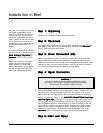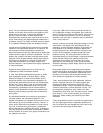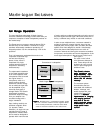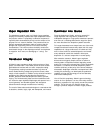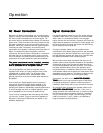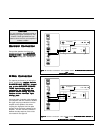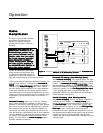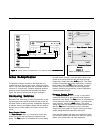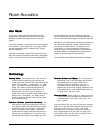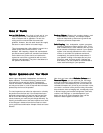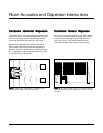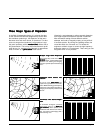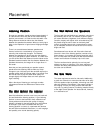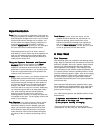
Page 12
Quest User's Manual
PassivePassive
PassivePassive
Passive
Bi-amplificationBi-amplification
Bi-amplificationBi-amplification
Bi-amplification
For those of you that desire ultimate
performance, the Quest may be
passively bi-amplified using the
existing internal passive crossover
elements.
WARNING! Only after the BI-WARNING! Only after the BI-
WARNING! Only after the BI-WARNING! Only after the BI-
WARNING! Only after the BI-
WIRE/BI-AMP SWITCH is in theWIRE/BI-AMP SWITCH is in the
WIRE/BI-AMP SWITCH is in theWIRE/BI-AMP SWITCH is in the
WIRE/BI-AMP SWITCH is in the
Bi-Wire/Bi-Amp position mayBi-Wire/Bi-Amp position may
Bi-Wire/Bi-Amp position mayBi-Wire/Bi-Amp position may
Bi-Wire/Bi-Amp position may
you connect individual runs ofyou connect individual runs of
you connect individual runs ofyou connect individual runs of
you connect individual runs of
speaker cable from your ampli-speaker cable from your ampli-
speaker cable from your ampli-speaker cable from your ampli-
speaker cable from your ampli-
fier to the Low-pass and High-fier to the Low-pass and High-
fier to the Low-pass and High-fier to the Low-pass and High-
fier to the Low-pass and High-
pass AMPLIFIER CONNEC-pass AMPLIFIER CONNEC-
pass AMPLIFIER CONNEC-pass AMPLIFIER CONNEC-
pass AMPLIFIER CONNEC-
TIONS binding posts. DamageTIONS binding posts. Damage
TIONS binding posts. DamageTIONS binding posts. Damage
TIONS binding posts. Damage
will occur to your amplifiers ifwill occur to your amplifiers if
will occur to your amplifiers ifwill occur to your amplifiers if
will occur to your amplifiers if
the BI-WIRE/BI-AMP SWITCH isthe BI-WIRE/BI-AMP SWITCH is
the BI-WIRE/BI-AMP SWITCH isthe BI-WIRE/BI-AMP SWITCH is
the BI-WIRE/BI-AMP SWITCH is
not in the correct position!not in the correct position!
not in the correct position!not in the correct position!
not in the correct position!
Operation
Figure 3Figure 3
Figure 3Figure 3
Figure 3. Horizontal passive bi-amplification. One channel shown.
BI-WIRE/BI-AMPBI-WIRE/BI-AMP
BI-WIRE/BI-AMPBI-WIRE/BI-AMP
BI-WIRE/BI-AMP
SWITCH in Bi-Wire/Bi-Amp position.SWITCH in Bi-Wire/Bi-Amp position.
SWITCH in Bi-Wire/Bi-Amp position.SWITCH in Bi-Wire/Bi-Amp position.
SWITCH in Bi-Wire/Bi-Amp position.
Passive bi-amplification takes the bi-
wiring concept one step further. Now
you will have a dedicated channel of
amplification directly connected to the
high and low-pass sections of the Quest crossover.
There are two different methods to passively bi-amplify. The
first, and most common, is referred to as
Horizontal Bi-Horizontal Bi-
Horizontal Bi-Horizontal Bi-
Horizontal Bi-
ampingamping
ampingamping
amping. The second method that is gaining in popularity is
referred to as
Vertical Bi-ampingVertical Bi-amping
Vertical Bi-ampingVertical Bi-amping
Vertical Bi-amping. With either method
you may use two stereo amplifiers or four mono amplifiers,
or two mono amplifiers and one stereo amplifier. Get the
idea? With either form of passive bi-amplification, your pre-
amplifier must have dual outputs. If your pre-amplifier is not
so equipped, you must either purchase or construct a "Y"
adaptor.
Horizontal bi-ampingHorizontal bi-amping
Horizontal bi-ampingHorizontal bi-amping
Horizontal bi-amping allows you to use two different
types, models or brands of amplifiers (i.e. tubes on top,
transistor on the bottom), assuming that they have identical
gain or that one stereo pair has adjustable gain. However,
we recommend that you use two identical amplifiers (i.e.
same brand and model). If the amplifiers of choice do not
have the same gain characteristics, then a sonic imbalance
will occur between the high-pass and low-pass sections of
the speaker, and integration between the two will suffer
greatly. The very nature of
vertical bi-ampingvertical bi-amping
vertical bi-ampingvertical bi-amping
vertical bi-amping dictates
that both amplifiers be identical.
Amplifier
Amplifier
OUTPUT
INPUT
OUTPUT
INPUT
OUTPUT
INPUT
OUTPUT
INPUT
OUTPUT
INPUT
Preamplifier
Horizontal Bi-amping (read Warning above).Horizontal Bi-amping (read Warning above).
Horizontal Bi-amping (read Warning above).Horizontal Bi-amping (read Warning above).
Horizontal Bi-amping (read Warning above).
With
horizontal bi-ampinghorizontal bi-amping
horizontal bi-ampinghorizontal bi-amping
horizontal bi-amping, one amplifier drives the high-
pass section while the second amplifier drives the low-pass
section. To
horizontally bi-amplifyhorizontally bi-amplify
horizontally bi-amplifyhorizontally bi-amplify
horizontally bi-amplify your Quests, connect
the low frequency amplifier to the
Low-Pass Input Low-Pass Input
Low-Pass Input Low-Pass Input
Low-Pass Input + and -
AMPLIFIER CONNECTIONS binding post. Connect the high
frequency amplifier to the
Full-Range/High-Pass InputFull-Range/High-Pass Input
Full-Range/High-Pass InputFull-Range/High-Pass Input
Full-Range/High-Pass Input
+ and - binding posts. Next, connect the left and right
preamplifier outputs to the appropriate left and right inputs
of both amplifiers.
See figure 3.
Vertical bi-amping (read Warning above).Vertical bi-amping (read Warning above).
Vertical bi-amping (read Warning above).Vertical bi-amping (read Warning above).
Vertical bi-amping (read Warning above).
With
vertical bi-ampingvertical bi-amping
vertical bi-ampingvertical bi-amping
vertical bi-amping, each of the stereo amplifiers is
dedicated to one speaker. To
vertically bi-ampvertically bi-amp
vertically bi-ampvertically bi-amp
vertically bi-amp your
Quests, connect the left amplifier channel of amplifier #1 to
the
Low-Pass InputLow-Pass Input
Low-Pass InputLow-Pass Input
Low-Pass Input + and - binding post and the right
amplifier channel of amplifier #1 to the
Full-Range/High-Full-Range/High-
Full-Range/High-Full-Range/High-
Full-Range/High-
Pass InputPass Input
Pass InputPass Input
Pass Input + and - binding post. Repeat the same
procedure for the other speaker with amplifier #2. Connect
the left preamplifier outputs to both inputs of the left channel
amplifier (#1) and the right pre-amplifier outputs to both
inputs of the right channel amplifier (#2).
See figure 4 on the
following page.



